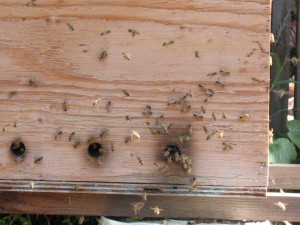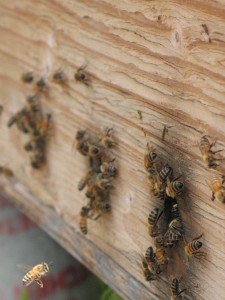Our top-bar hive, Mondo, is going into her third year. In the past two weeks, we have witnessed several mass orientation flights beginning at about 3:00 in the afternoons. We always call these ‘hatch-outs,’ as if a new generation of bees within the hive has emerged, thus graduating older bees to the status of foragers. These newly minted foragers must first orient to the hive to mark their place in the world.
The truth is, we’re not really sure that’s what’s happening. Sometimes we’re positive they’re about to swarm. Then again, mass orientation flights can disguise a virgin queen who is orienting before she goes out on a mating flight. In any case, it’s always exciting to watch. And it’s loud!
As we think about propagating our hives, we consider bee genetics, as expressed by their desirable and undesirable traits. Mondo has lived two years without treatment for diseases or pests, including Varroa mites, but that is about all we know, since I won’t let Sarah work the hive. Their home is a hastily built top-bar hive, rectangular and too deep. The bees have cross-combed between bars and attached comb to the sides of the box. The few times we’ve gone in, we’ve done a lot of damage.
We assume she’s a good honey-producer, since Dave, a direct progeny, was, and her bees are mostly mellow. This last trait, however, seems to be contingent on what’s happening in the hive. When I looked up into the hive several weeks ago, she seemed agitated and as I took photos yesterday, wearing my black vest, I received buzz-bys of various comment: back off, or, who are you?, or, get out of my way.
Many researchers now acknowledge that part of honey bees’ struggles results from their limited genetic make-up. Of the more than 24 recognized honey bee subspecies in the world, honey bees in the U.S. derive primarily from the Carniolan and Italian subspecies. Add that to the practice among queen breeders of instrumental insemination (vs. open mating) and you end up with a pretty limited gene pool. And limited genetics make for a limited ability to respond behaviorally or physiologically to challenges, such as pests, diseases, or a changing environment.
To some degree, honey bees are a domesticated animal. When we select for certain attributes, we inadvertently select for others, and deselect yet others. Mondo and her progeny seem driven to produce great quantities of queen cells, certainly more than I’ve read about in most literature or heard fellow beekeepers describe. Further, her virgin queens seem to prefer sorting things out after swarming, whereas most literature cites this sorting out as occurring before swarming. The swarm that became Mondo contained around 10 queens; Dave’s swarm had four that we counted; Hortensia had six, but a large subgroup departed the day after we hived them.
From a colony’s perspective, this behavior may be critical to creating, and testing, the mettle of new queens. But to a suburban beekeeper, these multi-queen swarms provoke ambivalence, especially as one hives a swarm for the second or third time.
But we’re still not sure why Mondo has lived for two years. Does she have ‘hygienic’ behavior, curtailing the spread of mites? Is it that we’re not in the hive disrupting things several times a year? Is it that we’re not taking honey? Is it the hive she’s made her home, spacious, with plenty of air circulation? Does she harbor two laying queens – not unheard of in large colonies – and thus have a back-up? Do her progeny colonies retain two queens?
The scientists, or lay scientists among us could probably sort it out, beginning with the most basic of observations from a monitoring board, and gradually moving their focus from inside the hive to inside the bees. While working in a psych lab in college, where we starved rats to 2/3 their normal body weight so that they would be ‘motivated’ by food in various experiments, I decided that observation might be the most powerful tool with which to learn. Observing some entity in situ may never provide all the answers, but neither does parsing its pieces out so completely that the whole is lost.
I am content to let Mondo do her thing, uninterrupted. You go, girl!



